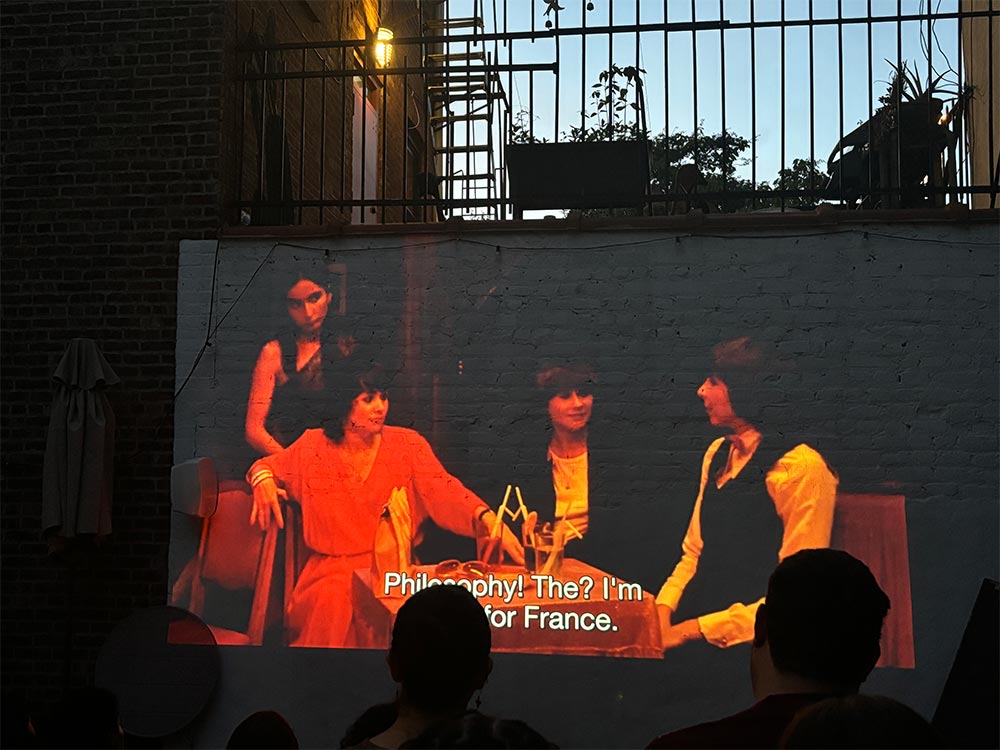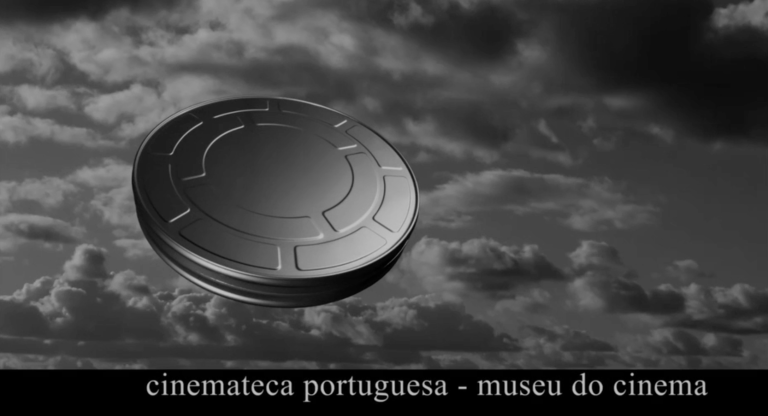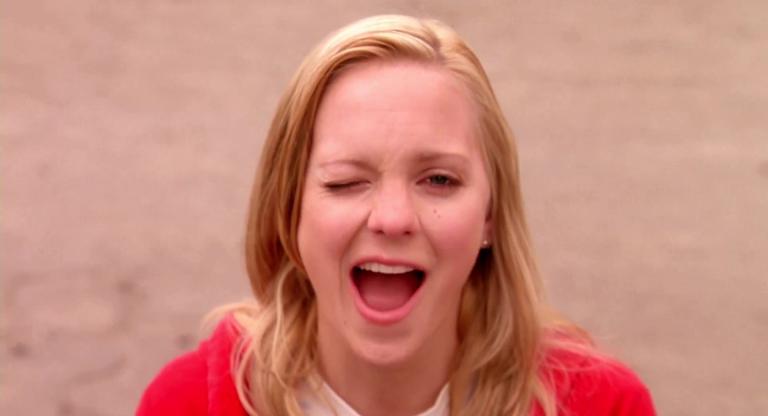Ordinarily, one seeks the refuge of movie theater air conditioning in the summertime. But New York is also host to a myriad of outdoor screenings, as well as outsider screenings, that cater to specific communities, their interests, and their taste. As far as the former goes, programming series like Films on the Green and Rooftop Films have established themselves as regulars in the outdoor movie scene. But the latter, encompassing screenings at bars, bookshops, basements, and similarly unexpected locales, have always had a more slippery presence in the New York film scene despite their evident popularity. These outsider screenings, conducted beyond the regular repertory circuit, are often ad hoc ventures. Yet, their popularity among local filmgoers feels more and more palpable; in part, due to their increasing regularity and their emphasis on aspects of film culture that remain untouched by most repertory cinemas.
The Bed-Stuy bookshop Dear Friend Books started hosting an outdoor film series in their backyard last summer. Organized by a rotating team of programmers, their film series includes a wide range of titles, each of which reflects the personal interests of the curator behind each screening. The cartoon company Cartuna has presented both The Muppets Take Manhattan (1984) and Gremlins 2: The New Batch (1990), two gonzo works of children’s cinema that couple technical artistry with so-called adult humor. Their programming resolves both a cultural and an educational function, reminding audiences that children’s cinema, and the subsequent films said kids are raised on as adults, can be more than CGI-drivel, in addition to showing that the appeal of art-forms like puppetry and animation extends beyond the world of children. This logic, which interrogates cultural precepts and narrow-minded interpretations of what cinema and the filmgoing experience can be, characterizes the Dear Friend Cinema project as a whole.
“It’s very free here, you have control to do whatever you want,” said Andrea Torres, who has been programming a series of lesbian films at Dear Friend Books and previously co-programmed the hit series Sapph-O-Rama at Film Forum in February. “They’ve opened up the space and are very accommodating to all the ideas that we have as curators.”
Both of the films she presented at Dear Friend Books received an incredible amount of guests. Not only were there no seats by the time I made it to these screenings, there wasn’t even any standing room left. Her first screening this summer, a showing of Lawrence Ah Mon’s Spacked Out (2000), saw her collaborate with FAR-NEAR, an artist-run book project dedicated to broadening perspectives of Asia. Alongside an introduction from Torres, the screening was also prefaced by a reading from FAR-NEAR contributor Lin King, who read an essay titled “Boys Over Ethics Over Aesthetics” that set up the film’s concerns with negligent boyfriends and reliable, though capricious, girlfriends quite well. But Spacked Out was rained out—an unfortunate, albeit predictable, threat that affects all outdoor summer events in New York.
Rain, much like mosquitoes, seating arrangements, imperfect projection, and faulty speakers, represent some of the hazards programmers working outside must contend with. But, because audiences attending such screenings are often quite understanding of the fact that they are participating in a DIY-circuit, these hazards also correspond to a series of concessions audiences make peace with in order to enjoy a purportedly once-in-a-lifetime event of humble origins.
Melissa Lyde, the Founder and Director of the Alfreda’s Cinema, whose mission it is to screen and support films that celebrate Black and non-Black people of color, noted that “any good programmer curates for the space they’re invited into” during a conversation we shared after her presentation of The Beginnings of Bebop (1981) and Speak’n Trane (2024) at Dear Friend Books on August 17. “It’s a bit of a hustle, you have to make it worth people's while,” she said. “You have to just approach it in the most clear, humble, and transparent way, acknowledging that the weather is something meant to be monitored and, if you're willing to, experience together.”
The threat of a thunderstorm loomed over the entirety of Lyde’s screening. Luckily, it did not start raining until after Speak’n Trane reached its end credits, after which guests funneled into the adjoining wine bar to chat amongst themselves and the stars of the film. Lyde’s program, which paired the historical and hilarious short film The Beginnings of Bebop with Shahkeem Williams’s new, deeply felt and delicate cinematic portrait of John Coltrane, gestured at the same cultural concerns as those present in Torres’s screenings. Mainly, a feeling that certain films and stories are not being represented in film exhibition; in this case, Black and lesbian independent productions, respectively.
“One of the most unfortunate reality checks for me has been that arts organizations, endowments, and foundations—they're not as willing to give over money to Black causes,” Lyde told me while discussing her ambition to start a micro-cinema that prioritizes Black cinema and audiences. “But even just sparking the idea to pursue this, despite it not being as lucrative as other careers and letting people know that they do have a place to show their work as Black and brown people, that there is a place for them, or that somebody is thinking of them in this way, that alone makes me feel like this is something worth fighting for.”
Though less political in its ambitions, Ella Sinskey’s Ditcher’s Eddy film series also came about in reaction to a void. Not only was Sinskey not seeing short films by young directors at cinemas she frequented, but felt that cinemas themselves inhibited community-building among budding filmmakers. “I don’t like hosting community screenings in movie theaters,” she told me over the phone. “There’s a time limit; usually, you can’t really stand around in the hallway; you have to find a place to go if you want to talk to somebody about it; and then, maybe you don’t know someone very well, so you don’t really even have the excuse to talk to them because you’re not technically smushed together.” Instead, the recent Ditcher’s Eddy screening I attended—a collaboration with the DIY-arts organization Saint Bimbo titled “Migraine Salon”—appeared to be organized around the principle of getting people to smush together.
Aside from the mélange of chairs and stools that offered a limited number of guests with seating accommodations at the recent Ditcher’s Eddy screening held in a Bushwick art-studio, there weren’t any determined spots for patrons to settle down and watch the films on view. As a result, most guests found themselves either plopping themselves down on the floor, standing and watching, or jumping in-and-out of the screening room—a gesture that recalls the sporadic viewing habits of the Surrealists, but felt more motivated by the heat that night endured and the attendees’ wavering attention spans.
“I have to agree with most people, and people who are very, you know, into cinema, that watching a movie in a basement with shitty speakers isn't the most optimal place, but I also think there's something very endearing about being slightly uncomfortable,” said Sinskey. “I went to a Saint Bimbo screening in a basement at Caffeine Underground and although it was uncomfortable, I had a great time because—we were sitting on milk crates, and every time we'd move, we'd fall over—at a certain point we just decided that we couldn't even see what was happening anymore and decided to just sit on the floor and wait for it to be over.”
At Ditcher’s Eddy screenings, it’s almost as though the films on view are performing a secondary function. After all, Sinskey started the series “as a way for people to have an excuse to get together and watch films.” Meaning, that community-building acts as the project’s primary function. But, having sat through “Migraine Salon” from the comfort of a lawn chair that situated me at an awkward viewing angle and pushed me to pay more attention to my surroundings than the screening’s short films, I’d argue there is no primary or secondary function at Ditcher’s Eddy. Instead, the sheer confluence of things happening at any given moment during one of Sinskey’s screenings approximate the design of an art-installation, making for a more lively, if not overwhelming, form of engaging with cinema.
Over the course of this month, as I attended one outside screening after another, it became more difficult to defend the fact that I was simply going to the movies. Although I had certainly enjoyed watching The Beginnings of Bebop, I had also found it extremely pleasurable to occasionally gaze up at the cloudy skies above, which made for a unique cinematic accompaniment because of the way in which they were framed by the bookstore’s neighboring buildings. At Ditcher’s Eddy I also found pleasure beyond the frame, mainly in talking to an old roommate I hadn’t seen in a while as the films played on. And, at a series of screenings organized by Rooftop Films at Fort Greene Park and Green-Wood Cemetery, I also found myself diverted by the idiosyncrasies of each venue.
Saidah Russell, Head of Programming at Rooftop Films, spoke to me a bit about how each site her organization works with influences their approach to programming. “Green-Wood Cemetery is one of our oldest and most beloved venues,” Russell said. “We really do program for that space, partially because it invites a specific kind of film and audience, and because there are certain rules we have to follow in order to be respectful of the space. Their biggest rule being, ‘the dead stay dead,’ so we can’t do zombies or vampires, unfortunately. But actually, and maybe surprisingly, a lot of our Green-Wood Cemetery programs are about death!”’
My recent trip to the Green-Wood Cemetery for Rooftop Films’ “New York Non-Fiction” program did make me think about death. To a certain extent, it’s unavoidable to think about death when you’re surrounded by graves, and more so when people are vaping and picnicking next to tombstones, but it was the program’s last film, Claire Read’s Pen F-ing Station (2024), that really made me think about how people come and go.
In her documentary, Read takes a close look at Governor Kathy Hochul’s “A New Penn Station” program. The plan, which aims to transform the derelict Penn Station into “a new commuter-first, world-class transit hub that also revitalizes the surrounding neighborhood” is also set to result in mass evictions when Vornado Realty Trust bulldozes the neighborhood and replaces its residential buildings with corporate offices. There, among the dead, this foreboding bureaucratic move startled me because of its naked villainy. At least, and much to my relief, was that the almost 1,000 guests immediately started booing when Governor Hochul popped up on-screen, and booed even louder when Mayor Adams showed up in a brief portion of the film.
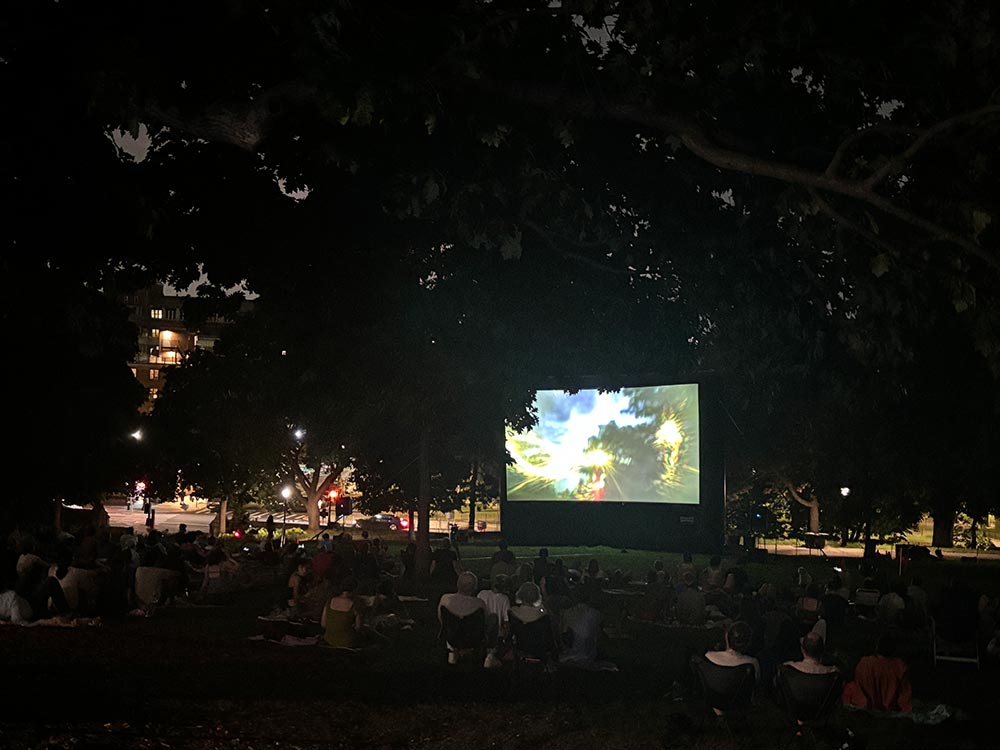
Attending Rooftop Film’s showing of Michael Gitlin’s The Night Visitors (2023) at Fort Greene Park proved a more peaceful experience. The screening, which took place on the lawn that extends down the north slope of the park, was complemented by the stir of insects. It was an uncomfortable, albeit appropriate, experience for a film about moths. Before The Night Visitors started playing on the 40-foot inflatable screen at the park, Gitlin said he could not imagine a more fitting venue for his film. He also pointed out that he had set up a light-sheet nearby with the hopes of attracting moths during the screening.
About halfway into the film, I got up to see if any moths had showed up. They had not, but there was a man—he did not appear to be interested in viewing the film at all—who stood by the sheet all night taking photos of the bugs it attracted, anticipating a moth. The lightsheet, though complimentary to the film, had become our own source of amusement, an extra-cinematic event in its own right.
Whether it’s in the form of a lightsheet, a reading, or a conversation, what the outside screening and outsider screenings offer are extra-cinematic occurrences. Not only do these screenings provide space for supplementary programming, or invite interventions by design, but the openness of their form can allow extraordinary things to happen, things that nestle themselves in memory because they invoke more than a movie or an outdoor scene, but a serendipitous elision between the two. At least, this is the only way I can describe the lesbian sword fight that preceded Torres’s screening of Marie-Claude Treilhou’s Simone Barbès or Virtue (1980) at Dear Friend Books.
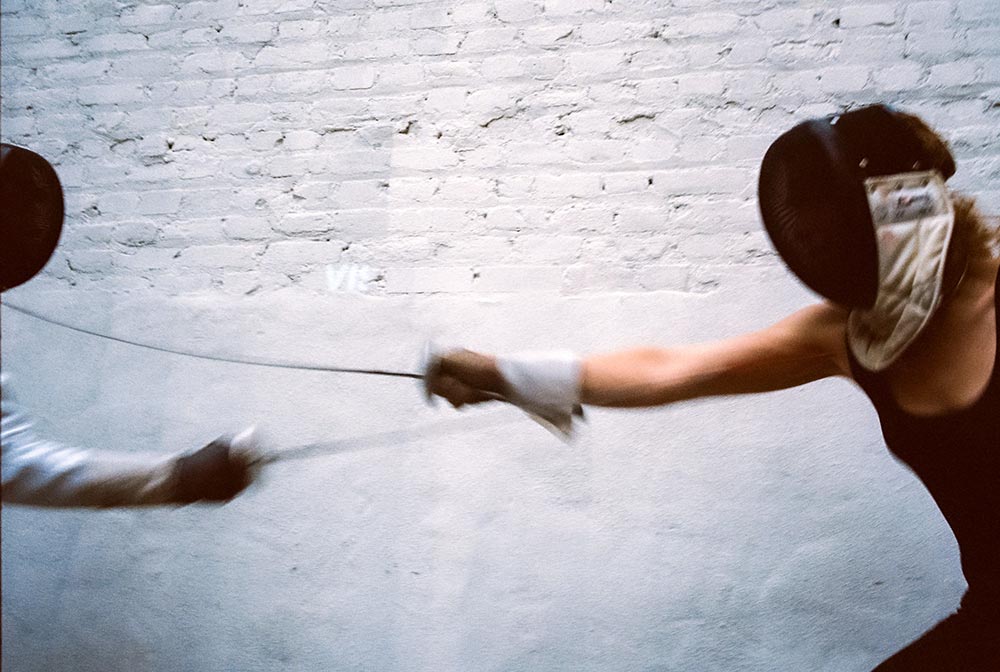
I observed this vaudevillian spectacle from across the backyard, perched atop a tree pot because there weren’t any seats left. Inspired by a scene from the film we were about to see, Torres and her collaborator, Sadie Bernstein (a former fencer in high school), had come up with an excuse to stage a sword fight before a live audience.
“I thought it would be a beautiful thing to recreate, to try to recapture the same kind of spirit of community and energy in a space that maybe isn't a lesbian bar, but is suddenly turned into one because that's who's here to see the movie,” Torres said. “Sadie really expanded the concept, bringing on a fencing partner to duel, and improvisational actors who, long story short, depicted a true old-fashioned sword fight for my hand in this magically avant-absurd send-up of lived-experience that I think was really reflective of that of many attendees… absolute dyke debauchery.”
This sword fight, though brief, shall remain synonymous with Simone Barbès in my mind forevermore, as will Fort Greene Park’s insects with The Night Visitors, lawn chairs with the films in “Migraine Salon,” and gravestones with the urban renewal depicted in Penn F-ing Station. I’m sure Torres’s special screening of Barbara Hammer shorts at Dear Friend Books on August 28 will make me develop similar associations between CRT TVs and the flickering, nighttime lights that will act as the installation’s backdrop. Before then, the sounds of the sea and whirring of airplanes that bleed through every screening at the Arverne Cinema will surely influence how I feel about the titles playing at the Rockaway Film Festival. For those of us who spend so much time watching movies inside, it’s always nice to step outside, to see where else the mind can go.
Feedback Loop is a column by Nicolas Pedrero-Setzer reflecting on each month of repertory filmgoing in New York City
Special thanks to Melissa Lyde, Saidah Russell, Ella Sinskey, and Andrea Torres.
